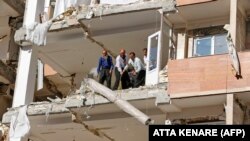More than a week after a 7.3-magnitude earthquake hit western Iran, icy rains are expected as many survivors still face a shortage of aid supplies such as heating appliances, tents, and plastic covers.
“The situation in earthquake-hit areas needs attention; otherwise, we are going to face a disaster worse that the earthquake itself,” Farhad Tajari, a member of parliament for Ghasr Shireen, was quoted by Iran Students News Agency (ISNA) as saying.
Referring to other problems in the area, including power outages and a lack of sanitary facilities, Tajari said, “Unfortunately, because of the poor distribution of relief packages, some areas have enough food but not enough clothes and other districts have the opposite.”
“The relief packages should be distributed according to the pre-measured needs of each area,” he added.
Tajari’s colleague, Sonqor and Kolyaei MP Javad Hosseini Kia, also criticized the disorganized aid distribution.
“The government has no high capacity for financial aid. Therefore, it is only offering 50 million rials (roughly $1,250) in gratuitous financial aid for villagers and 60 million rials (roughly $1,500) for city dwellers,” Hosseini Kia said. “With such minimal grants, people cannot get essential goods, let alone repair their damaged houses.”
Hosseini Kia noted that those who lived in houses built through the Mehr Housing Project were already struggling to pay their mortgages and now with the added expense of damages they would likely never be able to repay the loans.
Nevertheless, the government’s official news agency, IRNA, cited the head of the Planning and Budget Organization, Mohammad Baqir Nobakht, as saying, “The government will allocate roughly $160 million in loans and approximately $75 million as grants to households in quake-stricken Kermanshah Province.”
“Households in rural areas will receive [$6,200] in loans and [$1,250] as grants, while residents of urban areas will get loans to the tune of [$8,700] and grants worth [1,500],” IRNA quoted Nobakht as saying.
Meanwhile, Hosseini Kia insisted the number of the victims of the natural disaster is expected to significantly rise.
“The number could even surpass 1,000 since many areas have not yet been cleared of rubble,” he said.
Moreover, according to Tasnim, a news agency close to the Islamic Revolutionary Guards Corps, “A week after the earthquake hit Kermanshah Province, garbage and debris have built up in the streets, parks, and passages and around tents where survivors are sheltering.”
Ebrahim Shakiba, at the Medical Science University of Kermanshah, warned that the lack of hygiene in disaster areas could lead to the spread of disease.
“The trash in quake-hit areas is not being properly collected, and the danger of a cholera outbreak looms over those districts,” he said.
However, the Mehr Housing Project remains at the center of the criticism, described as a project teemed with corruption.
Most of the project was built during former president Mahmoud Ahmadineja’s presidency, when Iran has a high oil income.
Evidence seen from the earthquake areas shows that most of the Mehr apartment buildings sustained heavy damaged and contributed to the high casualty rate.
While the Rouhani government has singled out corruption in the building of these public housing units, Supreme Leader Ayatollah Ali Khameni’s representatives have defended the soundness of the project.



